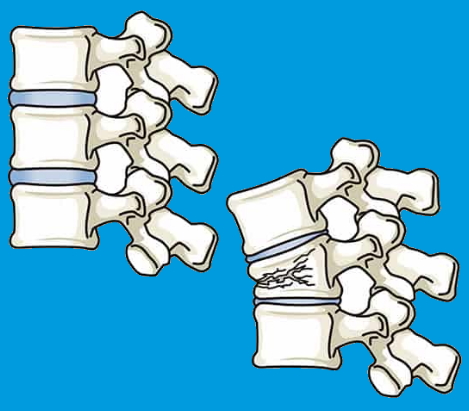Vertebral Compression Fractures
VERTERBRAL COMPRESSION FRACTURES Q & A
What Are Vertebral Compression Fractures?
Vertebral compression fractures (VCFs) account of 27% of all osteoporotic spine compression fracture cases in men and women. These fractures typically happen in the thoracic spine, that is the middle portion of the spine, especially in the lower part. The vertebral body in the spine collapses, due to compression on the bony structure. Osteoporosis, in addition to some cancers and injuries, can cause vertebral compression fractures. VCFs can lead to severe pain, deformity, and loss of height.
What Causes Vertebral Compression Fractures?
The thinning of bones, or osteoporosis, is the most common cause of VCF, affecting about 750,000 people each year. In patients with severe osteoporosis, simple activities such as sneezing, lifting a light object, or getting out of the shower may cause a VCF. In patients with moderate osteoporosis, a more impactful force or trauma can cause a VCF, such as a fall or lifting an object that is too heavy. VCFs are also found in some cancers, such as breast and kidney cancers, that metastasize to the bone and weaken it, causing spinal fractures. In addition, if trauma causes injury to the spine, VCFs can occur.


Frequently Asked Questions
Vertebral Compression Fractures Patient Education
What Are Vertebral Compression Fractures Symptoms?
Symptoms of VCF may include the following:
- Back pain that comes on suddenly
- Noticeable increase of pain when standing or walking
- Noticeable decrease of pain when lying on back
- Limited spinal mobility
In the long term, patients without treatment will notice:
- Loss of height
- Deformity of the spine (hunched posture)
- Muscle atrophy
- Disability
Who Is at Risk for Vertebral Compression Fractures?
Women have a higher occurrence of VCFs, as they have higher rates of osteoporosis. However, VCF is still a health concern for men. Age is also a factor. VCFs affect approximately 25% of postmenopausal women, with the number increasing to 40% in women 80 and older.
How Are Vertebral Compression Fractures Diagnosed?
A VCF can be diagnosed through medical history, an examination, and x-rays. However, a CT scan or an MRI will confirm the diagnosis and help physicians determine the best course of treatment.
Do Patients Need Treatment?
Yes. If conservative measures do not help with pain, further treatment will relieve pain and prevent further degeneration, disfigurement, height loss, and muscle atrophy.
How Are Vertebral Compression Fractures Treated?
Often physicians will begin with a conservative treatment plan, such as anti-inflammatory and pain medications, bed rest and physical therapy. If severe and debilitating pain persists, physicians will likely recommend kyphoplasty with vertebroplasty. This procedure treats the fracture to relieve pain and compression.
Specialized Patient Care
If you have received a vertebral compression fracture diagnosis and are experiencing the symptoms listed above, Dr. Jilbert Eradat can help. With expertise in treating VCFs with a minimally invasive procedure, Dr. Eradat gives each patient individualized attention. Major insurance plans and Medicare accepted.


631 West Avenue Q, Suite A
Palmdale, CA 93551
Phone 661-480-5956
Fax 661-480-5976
Hours
- Monday–Friday
8 am – 5pm
Resources
Connect

